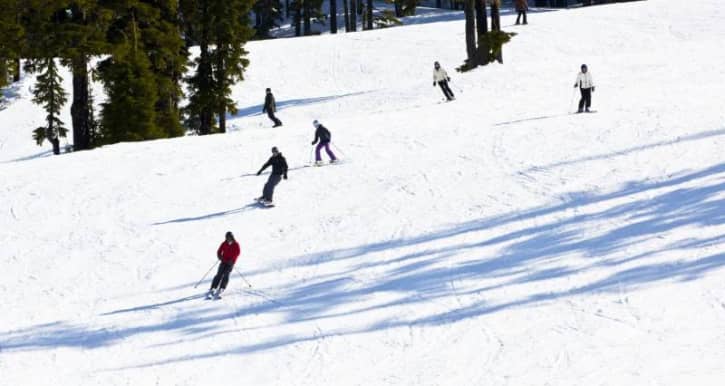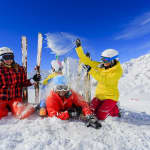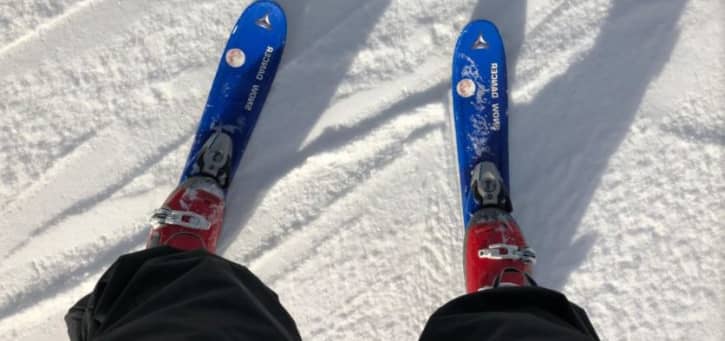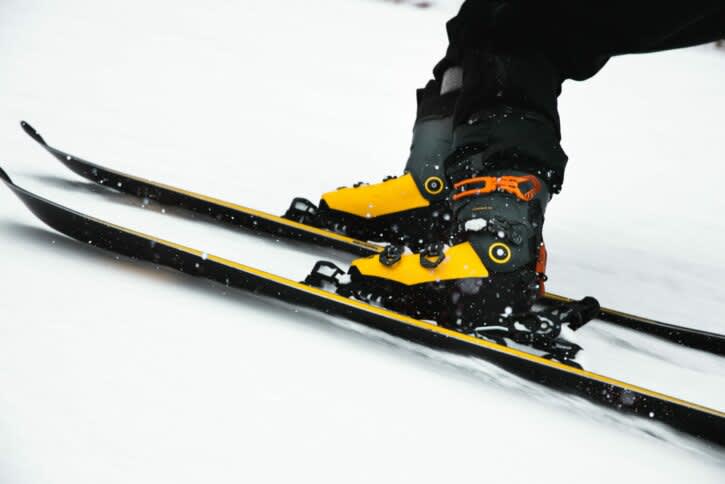If you’re going skiing for the first time, you probably feel a mix of excitement and intimidation. Sure, skiing looks awesome, but the idea of a human being going down a snowy mountain on two long planks might seem insane. At the very least, you’re probably thinking about what you need to do in preparation….
Luckily, you’ve come to the right place. Here’s everything that first-timers and beginner skiers should know before going hitting the slopes.
Contents
Mindset & Approach to Learning
Drop Your Ego
The very first thing that you should do — unless you’ve got some ice skating experience — is accept that you’re probably going to suck on your first day. Skiing is a very foreign concept to the human body. You’ve got to develop an entire library of new muscle memory that is completely different than most other athletic endeavors.
This does not mean that you shouldn’t have fun on your first day. As a matter of fact, there’s probably no greater satisfaction than stopping or turning for the first time. Spend your first day relishing in the learning process rather than thinking about becoming good or moving onto a hard trail.
Take a Lesson (Not From Your Spouse or Friends)
Instructor Teaching a Ski Lesson | Erge via Pixabay
The first time my wife went skiing, I was already pretty experienced. As such, I thought I was capable of teaching her to ski, but in retrospect, this was the very wrong approach. I should have gotten her to take professional lessons instead.
There’s two reasons for this:
- Being decent at skiing does not make you a good teacher. As a matter of fact, it could make you a bad one. Even though my wife was successfully going down blue trails, there was still a lot that she was doing technically wrong when it came to turning and stopping (that I didn’t have the eye to catch or point out). Just by happenstance, a ski instructor came by and corrected the issue with a few sentences. From there, she was able to move to black trails within a few days.
- By not getting taught by a friend or spouse, you’ll also avoid any potential arguments. Learning and teaching can both be frustrating experiences. If you’re not quite getting it, the person teaching you could get impatient, which will only further frustrate you. Leave it to the professionals, and you’re both likely to have a better time.
Relish the Small Accomplishments
You only get to do your first green trail (outside the bunny hill) or your first blue trail once. Much like other things in life, the first time is always the most magical.
Don’t Overestimate Yourself
Okay — so you’ve mastered the bunny hill, but that doesn’t mean you should move onto something much harder right away. As you get higher on the mountain, the trails usually become less groomed and more icy. Working your new techniques in harsher conditions is a completely different animal.
It’s worth not skipping ahead and doing the trails in their order of difficulty. Otherwise, you might end up biting off more than you can chew.
The Proper Gear
Renting vs. Buying Boots & Skis
The first time you go skiing, you absolutely do not need to buy your own skis or boots. Most resorts will have rental shops on-site, or there will be surrounding places where you can rent and get fitted. Since you don’t even know whether you’ll like the sport or not, it’s highly advised that you rent all your ski equipment the first time around.
As you start going more and more, you might wonder if it’s worth buying your own. According to the data we analyzed, buying your own skis, boots, and poles will begin to pay for themselves after around 19 days of skiing.
See Also: Renting Skis vs. Buying
If you don’t want to shell out all the money at once, it is worth considering buying just the boots. Getting your own pair of properly fitted ski boots will give you a balance of comfort and responsiveness that you won’t be able to find in rentals.
Staying Warm with Layering and Moisture Management
Now that the skis are covered, let’s talk about keeping warm — we have a full guide to keeping warm on the slopes — or you can keep reading for an abridged overview.
You might have a bunch of winter clothes laying around at home, and they could work for your first day if you’re sticking to an easy hill.
But layering up with a bunch of random garments isn’t ideal for snow sports. Here’s what you should do instead…
Moisture-wicking base layer: The first layer (the one in direct contact with your skin) is called a base-layer. For skiing, this base layer should be warm but also have the ability to wick moisture away from your skin.
My moisture-wicking shirt that I use for skiing.
Skiing is hard work, and even though it’s cold out, you’ll still work up a sweat. If your base layer isn’t working to lift that sweat from your skin, it will freeze up when you’re back on the lift and make you cold.
For my base layer, I really love Tesla Wintergear. Check the previous link for my full review on their winterized compression shirt and pants. It’s a rash-guard with a microfleece lining that’s the perfect combination of light and warm.
Insulating Mid-layer: In my opinion, you don’t really need anything that fancy for your mid-layer. I prefer to wear a fleece North Face jacket with fleece pants. Unlike cotton, polyester fleece won’t hold onto water. So even if snow or rain manages to get through your outer layer, it’s not going to reach your skin very easily; it’s simply going to evaporate away.
If it’s an especially cold day, you can put on extra garments in this layer for more insulation.
Waterproof outer-layer (or shell): The final layer is going to be your ski jacket and snow pants. This can be an extremely insulated layer, but it doesn’t have to be.
Depending on the conditions, you can get a heavy and expensive insulted ski jacket, or you can wear only a “shell.”
The most important thing is that this layer is 100% waterproof, but breathable. In the event that you fall (which you will on your first day), this layer will protect the rest of your clothes from getting wet.
I like to have a 3-in-1 jacket because it allows me to remove the extra insulating layer if it gets too warm. It also works for going out after because you can wear just the fleece and look pretty classy!
Also, don’t forget to put on snow pants! Your jacket will protect your upper body from moisture, but your snow pants will keep your legs warm and dry.
Head, Face & Neck
Keeping your head, face and neck warm is a matter of getting a decent ski mask (or balaclava) along with an insulated helmet. Most ski resorts will have helmets to rent, so you shouldn’t have to worry about that on your first time.
However, you will want to get your own balaclava. The most common mistake people make is getting one that holds onto water easily. In other words, a plain balaclava with no air hole or mesh venting system.
For that reason, I really like the Ergodyne N-Ferno balaclava. It’s super cheap, warm, and great for a first-timer.
Full Review (w/ Photos): Ergodyne N-Ferno 6823 Review
If it’s a warmer day, you might not need a ski mask at all. Instead, you can opt for a neck gaiter, which will provide a bit less coverage, but just enough for a milder day.
Eye-Protection
My cheap ski goggles
Keeping your eyes protected is important, even for beginners. While you probably won’t encounter massive amounts of wind and snowfall on the bunny hill, you still want to protect your eyes from the sunlight and provide some warmth for the areas around your eyes.
Some places might rent out goggles, but a decent beginner pair isn’t that expensive. Even cheap ski goggles nowadays come equipped with vents and dual-paned lenses so they aren’t likely to fog up as long as you don’t breathe into them while attaching your ski mask.
Read Next: Outdoor Master OTG Goggle Review
As you advance, you’ll probably want to have the ability to change lenses and get some extra color definition during flat light via advanced lens technology. Some more expensive goggles even have battery-powered fans that work extra hard to keep fogging at bay.
Hands
Keeping your hands warm should follow a similar layering principle to your body: a thinner pair of gloves that don’t hold onto moisture followed by a thicker, waterproof layer for the outside.
For the liner gloves, I really like the Storm Liners by Dakine. They provide enough warmth to ski in them solo on mild days, and they also have touchscreen capabilities and extra silicone grips.
On your first time out, you can get probably get away with a cheaper pair of waterproof gloves from your local outdoor store, but as you get to higher elevations, you may want to invest in some heavily insulated mittens with materials like Gore-Tex.
Feet
Properly fitting boots are an important factor in keeping your feet warm, but you’re probably not buying your own on the first time. That’s why it’s even more important to get proper ski socks and not just throw on your warmest pair of cottons. You’ll also want to avoid layering socks as it can mess with how your boots fit and cut off circulation (making you even colder).
There are many different types out there, typically wool, synthetic, or a blend of both. I prefer the synthetic microfiber Eurosocks. They’re affordable, durable, and make a great pick for a first time skier.
Using Your Skis
While you’ll surely be taking a lesson if you read the mindset tips, it doesn’t hurt to go in with the theory behind skiing. It will only help you learn faster, and your instructor will be there to correct the small nuances.
There’s tons of great videos online, but I highly suggest getting the Ski School App on your phone so you have easy access to information when you’re out there.
Getting Around
One of the first things you’ll find when you strap on your ski boots is that they’re not that easy to walk in. Because of their stiffness, they don’t allow your feet and ankles to flex as normal, making balancing difficult.
See Also: Best Ski Boots for Wide Feet
As the video above from Ski School App illustrates, you can use your skis and your poles for a little bit of extra balance. You should also use the front of your boots when going uphill and the back of your boots when going downhill. This gives you the most amount of balance and leverage.
Clicking Into Your Skis
Before you get onto the lift, it’s time to click into your ski boots:
Getting On and Riding the Lift
Now that you’ve figured out how to walk around with your skis on, it’s time to get onto the chair lift!
Here’s how to do it…
- Unstrap your poles. This ensures that they don’t get caught and drag you with them.
- Move to the marked loading area on the ski lift.
- As the chair lift approaches, sit down like you were sitting in a normal chair.
- Be sure to put the safety bar down — most lift accidents happen because people don’t do this part.
Getting Off The Lift
Getting off of the lift can be intimidating the first few times you do it, so here are some tips to make it happen smoothly:
- Don’t forget to lift the safety bar up in time.
- Point your ski tips UP — this will ensure that your skis don’t get caught in the snow making you fall forward as you get off of the lift.
- Stand up, and let momentum propel you forward.
- Use this little bit of momentum to get out of the way of the next rider.
Stopping
When you first start skiing, your instructor will most likely introduce you to the “wedge,” “snowplow,” or “pizza” method of stopping. This way of stopping involves using your heels to push out so that your inside edges create resistance in the snow. It’s the easiest way to stop and slow down for beginners because you don’t need to be fully in-sync with both legs at once to pull it off — unlike doing a hockey stop or stopping parallel.
Turning
You can also use the snowplow method to turn when you’re starting out. Rather than wedging with both skis at the same time, wedging with only one will result in a turn rather than a slowing and stopping. It’s an easy way to get around on your first day and avoid crashing into people on the bunny hill.
Advancing to Parallel Skiing
If you manage to get a handle on the beginner maneuvers, you’ll want to start learning to use both your edges simultaneously. This is what you see expert skiers do as they move from side to side.
I’ve seen this transition from wedge to parallel described in a few different ways. Some instructors describe it as “rolling the skis,” while others describe it as “tipping one ski and letting the other one follow.”
To be honest, the parallel movements are a lot more difficult to describe and something you just have to get a feel for. Given my experience with hockey and ice skating, I probably have a slightly different technique than someone who learned to ski first.
Once you feel comfortable with the basics, you should take another lesson. Just as the first lesson gave you what you needed to work on for the basics, a follow up lesson (or lesson package) will help you nail down the nuances of parallel skiing.
The Trail Rating System
After your initial lesson, you might end up venturing on some of the different lifts and going on some new trails. That’s why it’s important to know the rating system. Ski mountains are decorated with signs so that you know the difficulty of each trail.
Here’s what the colors and shapes on the signs mean (steepness rating source):
- Green Circle: These are the easiest trails at the resort, and you’ll probably want to stick to these your first few times. Steepness can differ depending on the mountain itself. These trails are generally the most wide with 6% – 25% steepness gradient.
- Blue Square: These trails are more difficult than greens, but aren’t quite expert trails. The terrain is usually a bit more varied than greens, with steeper parts scattered throughout. Blue squares have a 25% – 40% steepness gradient.
- Black Diamond: This is where it gets steeper and far more dangerous for a beginner. Black diamonds often go beyond 40% steepness and have can have very difficult terrain.
- Double Black Diamond: This is just a harder version of a black diamond. Their difficulty levels vary by resort, but don’t expect to do any double blacks for a while if you’re starting out.
- Orange Oval: These are terrain parks. The trails themselves are typically quite easy if you don’t mind going around the jumps.
General Good Practice
Be Courteous and Know Ski Etiquette
If you’ve never seen it before, you should check out the official skier responsibility code. Some of the code rules are obvious and a bit too common sense (such as not going into closed areas), but other parts might not be obvious to a new skier:
- It is your responsibility to avoid people ahead of you, they have the right of way*.
- Never stop in a place where you’re not visible to people higher on the mountain or where you’d be blocking a trail.
- When merging, look uphill to yield to others.
- Show the utmost respect to other skiers.
*You shouldn’t yell at people to move out of the way out of rudeness, but if you happen to lose control, a vocal heads-up can be helpful.
Travel Insurance
If you’re going to another country, or unsure if your health insurance is going to cover you for a ski accident, it’s worth getting travel insurance. I’ve found that it’s not very expensive at all. It’s also nice for peace of mind. The only thing worse than hurting yourself is wondering how you’re going to pay for the medical bills afterwards. Plus, travel insurance can cover you for all sorts of other mishaps beyond injury. It’s worth doing your due diligence before heading on your trip.
To save money, consider using a travel insurance comparison tool like this one from Quote Goat.
Arrival Time
If you’re buying (or picking up) your lift tickets on-site or renting your equipment, it helps to arrive early. You only have a limited amount of time to ski before the resort closes, so you want to minimize the time spent waiting in line. As the day goes on, more and more people will arrive, and rental wait times can sometimes be an hour or more!
Bring Snacks
Having some snacks you can munch on the lifts will mean that you won’t have to take a long break for lunch. Be sure to pack snackable foods in small pouches or Ziploc bags, and try to limit the candy and junk food. Stopping in the lodge for food is usually pretty expensive, so doing this will also help you save some coin.
Read Next:27+ Snacks to Eat While Skiing
Stay Hydrated
Hydration is often overlooked when skiing. You’ll find a lot of people drinking alcohol (which is dehydrating) or forgetting to drink water between runs. You could carry a hydration pack, but if you don’t have one, be sure to drink up during your breaks. Lodges usually have easy to access water fountains, so you don’t have to buy a drink.
More Details:Staying Hydrated on the Ski Slopes
Ski With a Friend
This isn’t really necessary when you’re with an instructor, but after your lesson, be sure to ski with a friend. The last thing you want to do is end up lost if you’re having trouble getting around.
Have Your Phone on You (and get the Ski Patrol Number)
You’ll never know when you’ll need your phone, so try not to leave it behind. If you get separated or lost from your friend(s), they’ll only be a phone call away assuming you have service. You’ll also be able to call the ski patrol if anything bad happens to you or you see someone else get injured. Be sure to keep their number handy before you go up on the lifts.
See Also: Keeping your phone warm and safe while skiing.
Have Fun!
Last but not least, remember to have fun. For most people, a day on the slopes is a much needed relief from the daily grind of work. Immerse yourself in the beautiful scenery, and relish everything that the mountains have to offer!












